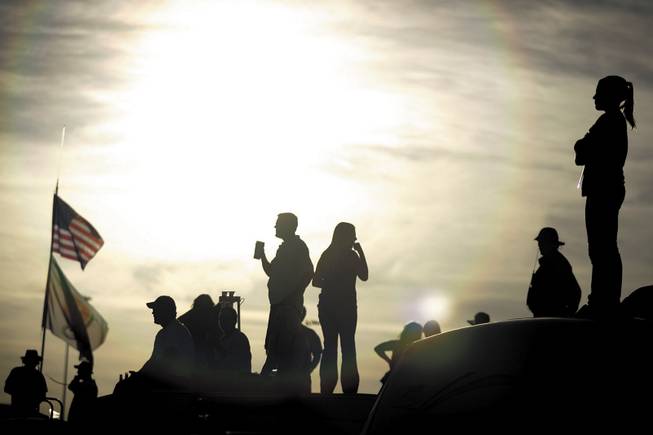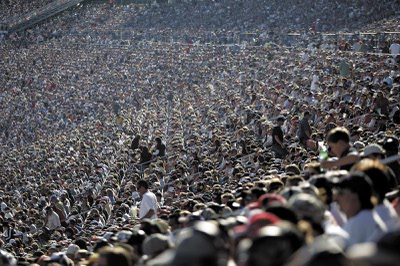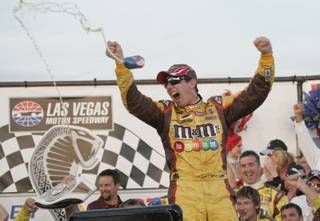
Fans stand on their RVs in the infield to get a better view of the track during the Shelby 427 Sprint Cup Race Sunday at the Las Vegas Motor Speedway. The race is Nevada’s biggest sporting event.
Monday, March 2, 2009 | 2 a.m.
Long before Kyle Busch, the hometown kid with an anvil for a right foot, sped under the checkered flag at Las Vegas Motor Speedway late Sunday afternoon, racing fans of all shapes, sizes and colored T-shirts with their favorite driver’s picture on front began pulling their SUVs and pickup trucks into the massive parking lots abutting the 1.5-mile speed plant.
The Candy Man Can
In his M&M-sponsored car, hometown driver Kyle Busch snagged his first career win at Las Vegas Motor Speedway in Sunday's Shelby 427.
Living in Fast Forward
Check out the sights and sounds of what life is like living at a racetrack for a weekend.
Keeping Pace
Ever wonder what it's like to drive at racing speeds around a NASCAR track? Watch as 702.tv sports reporter Christine Killimayer rides along with Sprint Cup Series pace car driver Brett Bodine at Las Vegas Motor speedway
Remembering Chris Trickle
Barbara and Chuck Trickle remember their son, Chris, a NASCAR driver who was murdered 11 years ago.
Sun Archives
- Younger Busch using lessons learned in Vegas (3-1-2009)
- Busch brothers qualify 1-2 for Shelby 427 at LVMS (2-27-2009)
- Busch brothers happy to be back home (2-27-2009)
They kept coming ... and coming ... and coming.
And coming.
Nobody saw that last “coming” coming.
This was supposed to be the year when there were going to be acres of empty seats at our NASCAR Sprint Cup race. The economies, both national and local, are like a set of Goodyears that badly needs changing. You can see clear down to the steel belts.
Sellout? No way. Ten days ago, speedway officials said ticket sales were down 15 to 20 percent. Which really means 25 to 30 percent. This economy is killing us, they said. Plus, the price of gas on the interstate is going up again. That hurts when 70 percent of your audience uses the Interstate Highway System to get here.
Last week, I was watching the race at California when Larry McReynolds said on TV that everywhere he looked there was a bunch of people. I don’t know how he defines “bunch” but I define it as the grandstands being more than half full, which is about all they were.
Then Darrell Waltrip started talking about how he couldn’t wait to get to Las Vegas, where there would be a Dale Earnhardt Jr. fan — and maybe a couple of guys wearing tasseled loafers cheering for Busch — in every seat. It’ll be a sellout, D.W. said. It always is.
Now I know what ol’ D.W. was doing during those rain delays. He must have been sucking fumes off the Jim Beam Toyota right out of the tailpipe.
But ol’ D.W. was almost right. By Saturday, the speedway was predicting a sellout. So it printed up some more tickets, or at least some $50 general-admission credentials.
Most of those GA seats, down low in turns 3 and 4, weren’t occupied when the green flag fell. There were lots of empty seats in that area of the track. But otherwise, the place was packed, as usual. It still took a long time to get a beer — and even longer to clear the parking lots.
There was a report that by the time the last pickup truck was headed back to Kannapolis the economy was better. Nobody would confirm it, but it’s better around here than it was on Thursday, that’s for sure.
“The recent surge in interest for Sunday’s race is a testament to the strength of NASCAR and the true passion of NASCAR fans,” speedway President Chris Powell had said on Saturday.
Well, I wouldn’t say NASCAR is exactly bench-pressing manhole covers in victory lane. This lousy economy takes no prisoners. Some of the Cup teams have had to merge to continue going around in circles, and judging from the lack of sponsor patches on the fire suits of the Nationwide Series drivers, the money isn’t trickling down like it used to.
All I know is that Bill Simpson has gotten a ton of free publicity from this recession. His company makes the generic fire suits the drivers and crew guys wear when they can’t get real sponsors to put their names on front.
But Powell also said that “despite a challenging economy, this event continues to deliver great benefits for Las Vegas.” Not even Tony Stewart could argue with that, and he argues with almost everything.
“I had my doubts a couple of months ago that we’d get so close to a full house,” Powell said.
Powell said ticket renewals were strong among fans who attended last year’s race. But that was before the economy tanked like Erwin Rommel during the Siege of Tobruk.
Sales were weak when tickets went on sale to the public. A lot of the economist types say the rubber won’t really hit the road in NASCAR until next year, because race fans, like race teams, plan their budgets a year in advance.
“If the economy gets better, I’ll be back to Vegas next year,” said Kirby Coleman, an air traffic controller from Fresno (by way of Milwaukee) who said he tries to get to at least two NASCAR races every season. “If not, I’ll probably just go to Fontana or somewhere like that.”
Las Vegas Mayor Oscar Goodman wore a natty Panama hat to the track on Sunday that sort of made him look like Ernest Hemingway, were it not for the showgirl on each arm. He told the big crowd the bell is tolling for a second NASCAR weekend here.
I have never been a big fan of a second NASCAR race weekend here. I don’t think two races would sell out, even when the investment bankers are spending money that actually belongs to them. Most guys I know back home have money for one Las Vegas trip every year. I suspect race fans are pretty much the same.
But even if a second race attracted “only” 80,000 spectators, it would still be the second-largest sporting event in Nevada by oh, about 40,000 spectators. People who travel here for sporting events — except BYU fans — usually leave a lot of their discretionary dollars behind.
We could use their cash. When you flip a house, it shouldn’t be heads you lose, tails you lose, like it is around here now.
Last year, NASCAR weekend generated an estimated $189 million for the local economy. It’ll be a little less this year. Besides those empty seats in turns 3 and 4, the price of a beer was lowered by a buck this year, from $6 to $5. Who says NASCAR isn’t fan friendly?
Multiply that $1 by the NASCAR average of 10 cold ones per race (a dozen if there’s a rain delay or a bunch of yellow flags, like there were on Sunday) and speedway Chairman Bruton Smith might have to hold off repaving the track again, or building another infield media center when somebody from Charlotte spills a cup of coffee in the new one.
So instead of $189 million in economic impact, maybe it’ll be closer to $169 million this year. If there’s one thing I’ve learned while covering these races, it’s that NASCAR fans can drink a lot of discounted beer.
Pardon me for not sneezing.
As for all those NASCAR fans from Kentucky who kept stepping on my new sneakers in the Neon Garage, I’ve got only one thing to say:
Y’all come back now, ya’ hear.



Join the Discussion:
Check this out for a full explanation of our conversion to the LiveFyre commenting system and instructions on how to sign up for an account.
Full comments policy